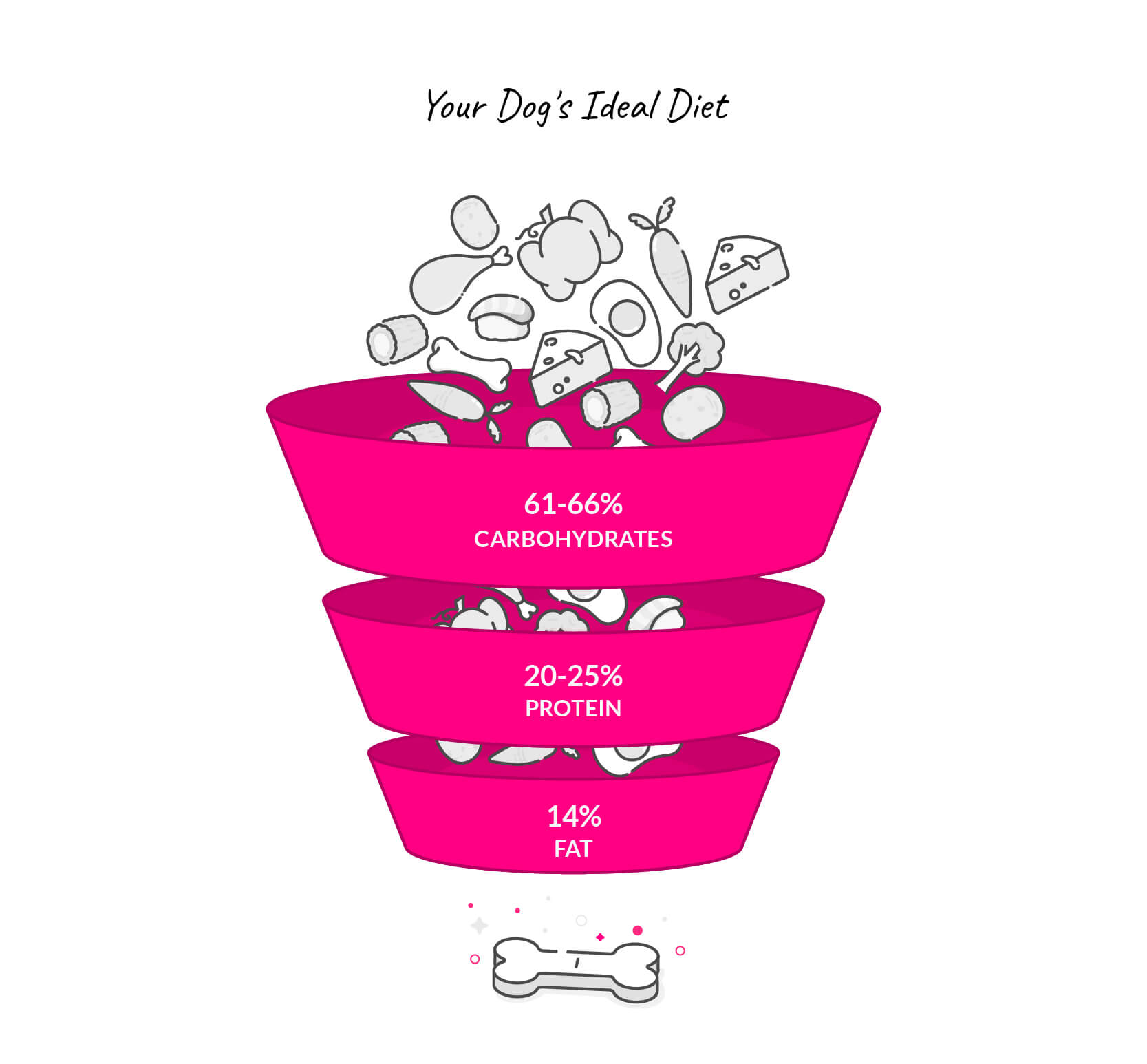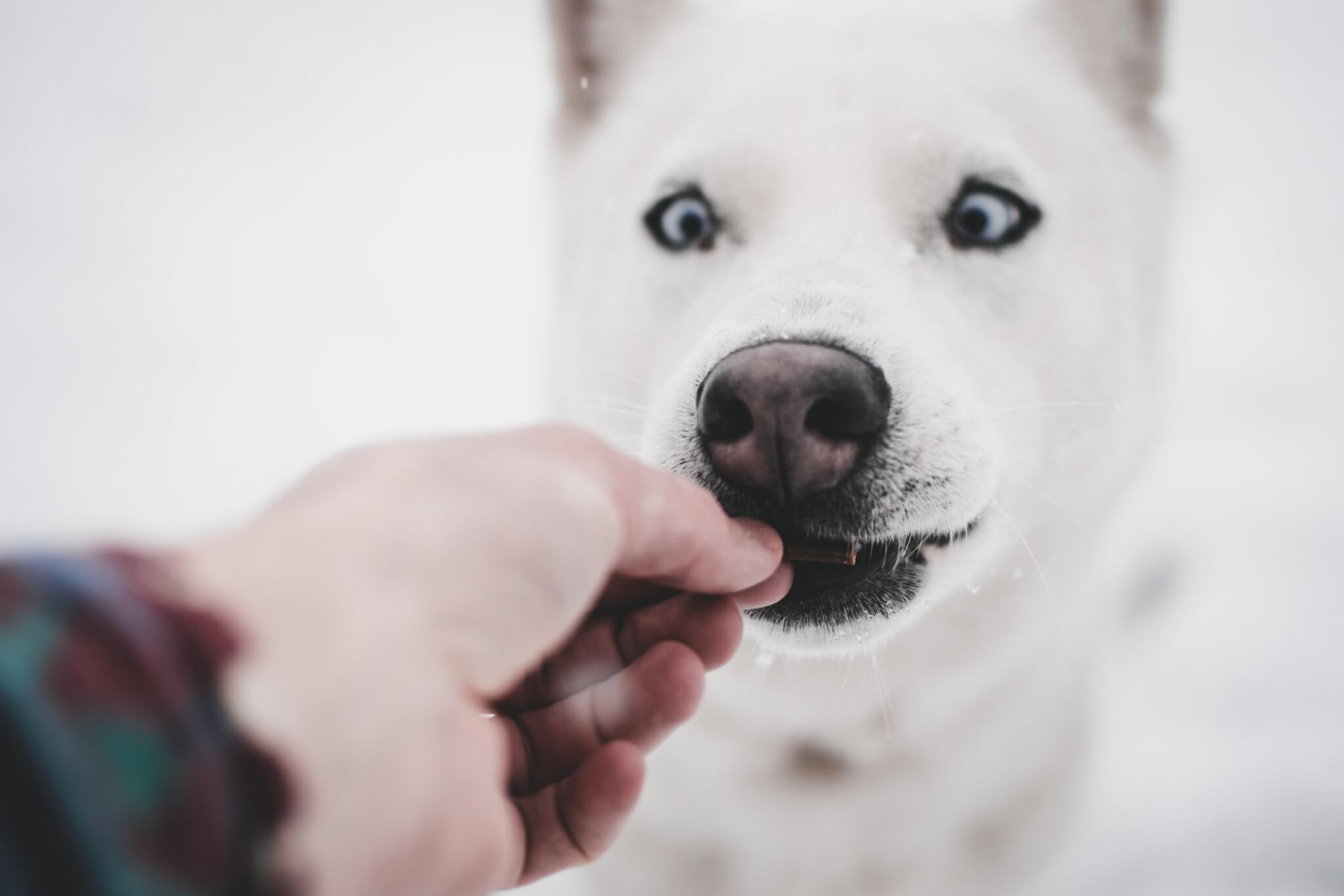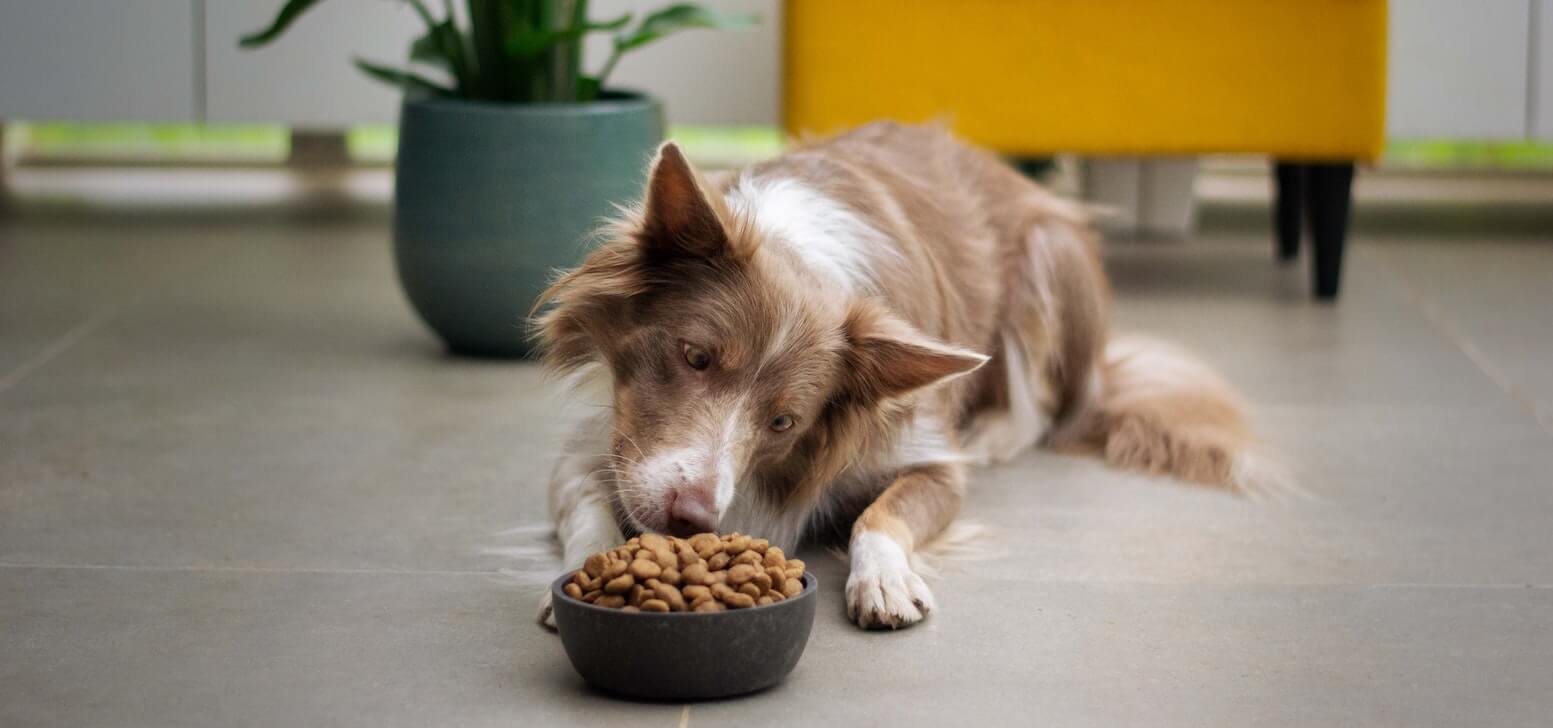- What are a dog’s basic nutritional needs?
- Should I feed my dog wet or dry food?
- How are a puppy’s nutritional needs different from those of an adult dog?
- Can dogs ever eat “people food”?
- Are “raw” food diets healthier for my dog than more typical dog food?
- How often/how much should I feed my dog?
- What should you do if your dog isn’t eating?
- What about dog treats?
- Can you feed a dog a vegetarian diet?
Chihuahuas, Cockapoos, Great Danes—no matter their size, a dog’s gotta eat! But how can you be sure that bag of kibble or can of wet food is giving your pup the fuel they need to play, snooze, cuddle, and thrive?
Luckily, Lemonade’s favorite veterinarian, Dr. Stephanie Liff is here to answer some of the most common dog nutrition questions that a dog owner might have.
What are a dog’s basic nutritional needs?
According to Dr. Liff, there is some basic math to help you understand if your dog is eating the way they should. Take a close look at those nutritional labels and see how your pup’s diet stacks up.
These are the building blocks of your dog’s diet:
- 20-25% protein (poultry, pork, beef, or fish)
- 14% fat (from meat, dairy, eggs, or plants)
- 61-66% carbohydrates (things like wheat, barley, corn, potato, millet, oats, or rice)

Also, make sure your dog’s diet includes vitamins and minerals like iron, selenium, and sodium. Foods that don’t follow AAFCO (Association of American Feed Control Officials) standards might be missing these essential nutrients. Look out for the AAFCO seal on your pet food to guarantee it will provide your pup with adequate nutrition.
Dr. Liff advises that dog parents tune into their individual pup to really understand if their food intake is working for them. “It’s important to feed a diet that your dog does well on,” Liff explains, “which means they eat it, they maintain a healthy weight, and they produce well-formed feces.” (Speaking of that last point—we’ve got a lot more info about what your dog’s poop might be saying about their health.)
Dr. Liff recommends choosing food made by companies that have done exhaustive research to ensure their food provides a high-quality balanced diet that is nutritious and tasty (think brands like Royal Canin, Hills, and Purina.)
Should I feed my dog wet or dry food?
According to Dr. Liff, there’s no need to stress over whether you go with a 100% kibble diet, or a 100% wet food one; either option could provide your dog more than adequate nutrition.
She does note, however, that kibble can be healthier for oral health, since chewing through kibble can help remove tartar on your dog’s teeth (sort of like how eating an apple cleans our human teeth about as well as a vigorous brush). Of course, you could plan a hybrid diet to get the benefits of both types of food.
TIP: A complete wet food diet can cost around six times more than the dry food equivalent. Looking to pamper your dog without breaking the bank? Feed them an 80% kibble, 20% canned food diet to give your pet some variety.
How are a puppy’s nutritional needs different from those of an adult dog?
Puppies have higher fat and protein requirements, and specific calcium and phosphorus requirements to support rapid growth.
Don’t take on any guesswork when it comes to feeding your puppy, Dr. Liff recommends. Look out for dog food specifically labeled for “growth,” or identified as “puppy food,” otherwise your sweet pup might become malnourished.
Can dogs ever eat “people food”?
Human food can definitely be on the menu for your dog, according to Dr. Liff. She says you’re welcome to serve your pup lean meats and fish cooked with minimal oil and spices. Vegetables (besides onion, garlic, and avocado) and fruits (besides grapes) are mostly starches, and are also safe to serve to your pup as a snack.
If you do choose to put out a plate for Fido, be sure to factor in those calories into your pet’s overall diet plan. And of course, keep an eye out for any digestive upset. We’re not going to say it’s a disaster if you slip your dog the odd slice of pizza—some dogs are absolutely mad for a hot, cheesy pie—but you probably don’t want to be letting your pet finish off all your takeout orders.
For example, Hudson the Golden Retriever loves to indulge in the occasional “puppucino”.
Are “raw” food diets healthier for my dog than more typical dog food?
In recent years, there has been an influx of raw dog food companies offering subscription services for fresh “ancestral” diets, made up of whole foods, and designed for your dog’s health and longevity.
While these diets may have vocal supporters, Dr. Liff isn’t convinced.
“There is no research to support improved lifespan or health from raw diets,” she says. “They are generally very palatable, and often meet nutritional requirements, but can have quality control issues. Think bacterial contamination.” Yikes.
How often/how much should I feed my dog?
“Two meals a day is ideal,” says Dr. Liff, for dogs over 6 months old.
Keep in mind that puppies require more daily meals than their adult counterparts.
“Puppies up to about 6 months old should eat 3 to 4 meals a day to help manage growth requirements and maintain stable blood sugar,” explains Dr. Liff.
Like the nutritional label on human food, the serving size on your dog’s food is just a recommendation. Dogs should be fed with the goal of maintaining their ideal body weight, which is a 5 out of 9 on the body condition score, but might vary based on their age and activity level.
If you’re unsure or concerned about your pet’s weight, have a conversation with your vet to make sure your dog isn’t at risk of becoming underweight or developing canine obesity.
What should you do if your dog isn’t eating?
If you notice a change in your dog’s eating habits—if they stop eating, or if you notice weight loss—it’s time to go to the vet.
“Some dogs are not food-driven and will eat just enough to maintain their health,” Dr. Liff notes. “Sometimes, dogs won’t like the food they’re fed and will refuse it to the point of illness.” Woof.
If the issue is your dog’s food, and not an underlying health issue, you can try to make your dog’s food more enticing. Adding a bit of low-sodium broth, cheese, vegetables, or cottage cheese can make for a tastier experience for your dog. Brands like Stella & Chewy’s also sell dog food toppers, designed to kick your pup’s food up a notch.
What about dog treats?
Dog food is formulated for complete canine nutrition, while treats are usually formulated to taste and smell awesome to your dog. That’s totally fine, of course, if you practice moderation.
After all, everybody deserves a treat sometimes. In fact, we’re going to go have one as soon as we finish writing this article.
The amount is key when it comes to treats, according to Dr. Liff. If you’re feeding your dog a lot of treats, account for that caloric intake, and cut back at mealtime—and always be on the watch for weight gain.
Want to go DIY and craft your pup something tasty? Check out this fun and easy recipe for homemade dog treats.

Can you feed a dog a vegetarian diet?
Being a vegetarian or vegan pet parent can present a real conundrum. You’ve chosen to avoid meat and animal products for ethical or environmental reasons—so can you make the same choice for your fur fam?
Let’s face facts: The domestic dog’s ancient ancestor, the wolf, is a carnivore. Your pug might be a far cry from his roots, but her nutritional needs are not.
Dr. Liff says that although there are some balanced and complete vegetarian diets on the market, a dog may still struggle to meet their minimal nutrient requirements if they are strict vegetarians (we’re looking at you, Elle Woods).
If you want to be conscious of how the meat in your dog’s food was sourced, there are plenty of meat-based dog food brands that use free-range poultry or grass-fed meat, like Acana, Orijen, FirstMate, and The Honest Kitchen.
If you’re looking for a health-conscious subscription service to bring quality dog food right to your door, here’s a rundown of some top-rated options.
Before we go…
We know you want to do everything in your power to give your dog the best life possible. Adequate nutrition and having a vet you trust are two vital parts of nurturing your dog’s long-term health and to your peace of mind.
If you’re a pet owner looking to help take the bite out of vet bills, Lemonade offers customizable pet insurance to cover your pup (or cat!) from whatever life throws at them. Learn more about the basics and beyond of pet insurance for dogs, or apply for a pet insurance quote. It’s fast, easy, and as fun as a trip to the dog park.




